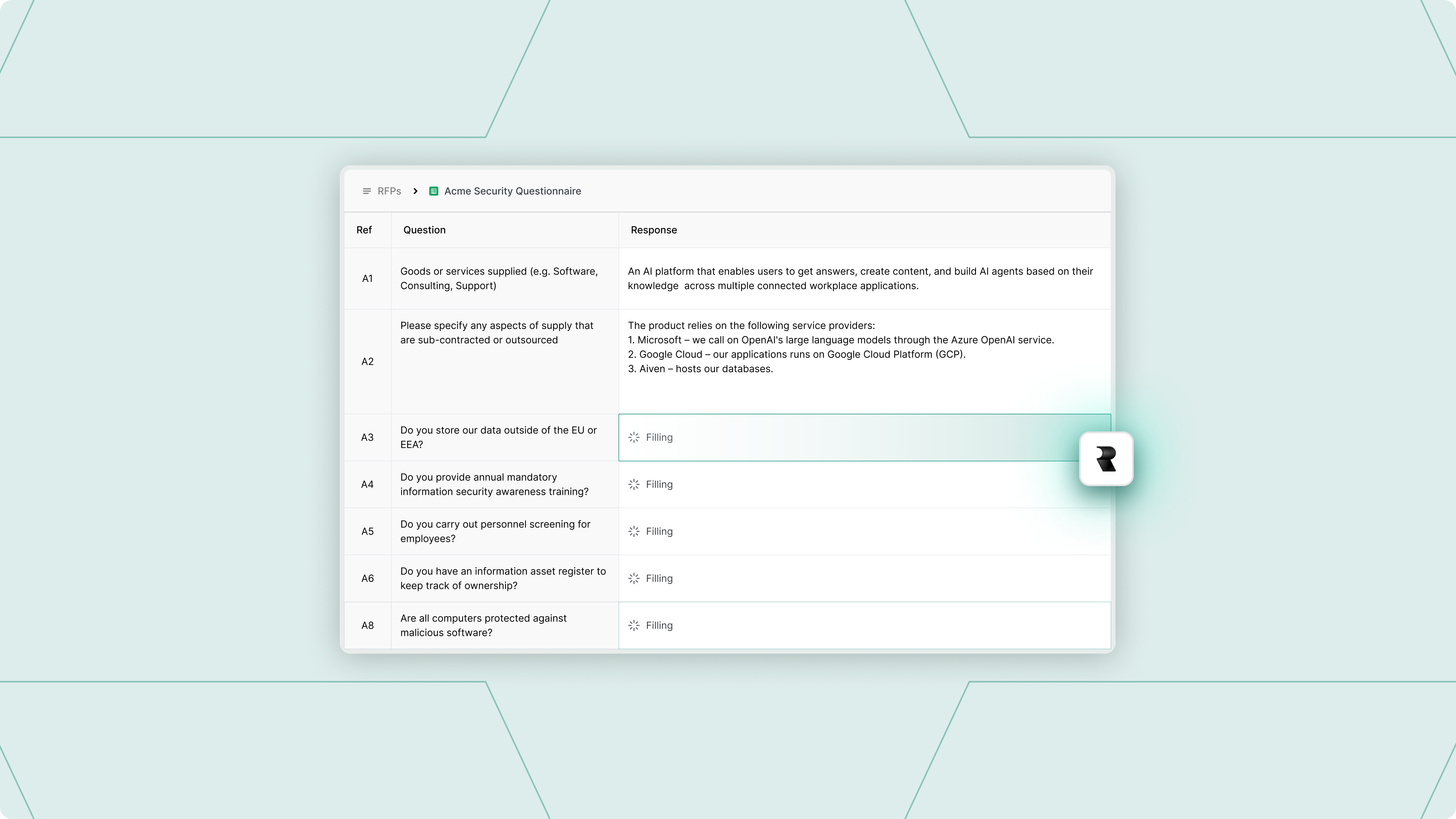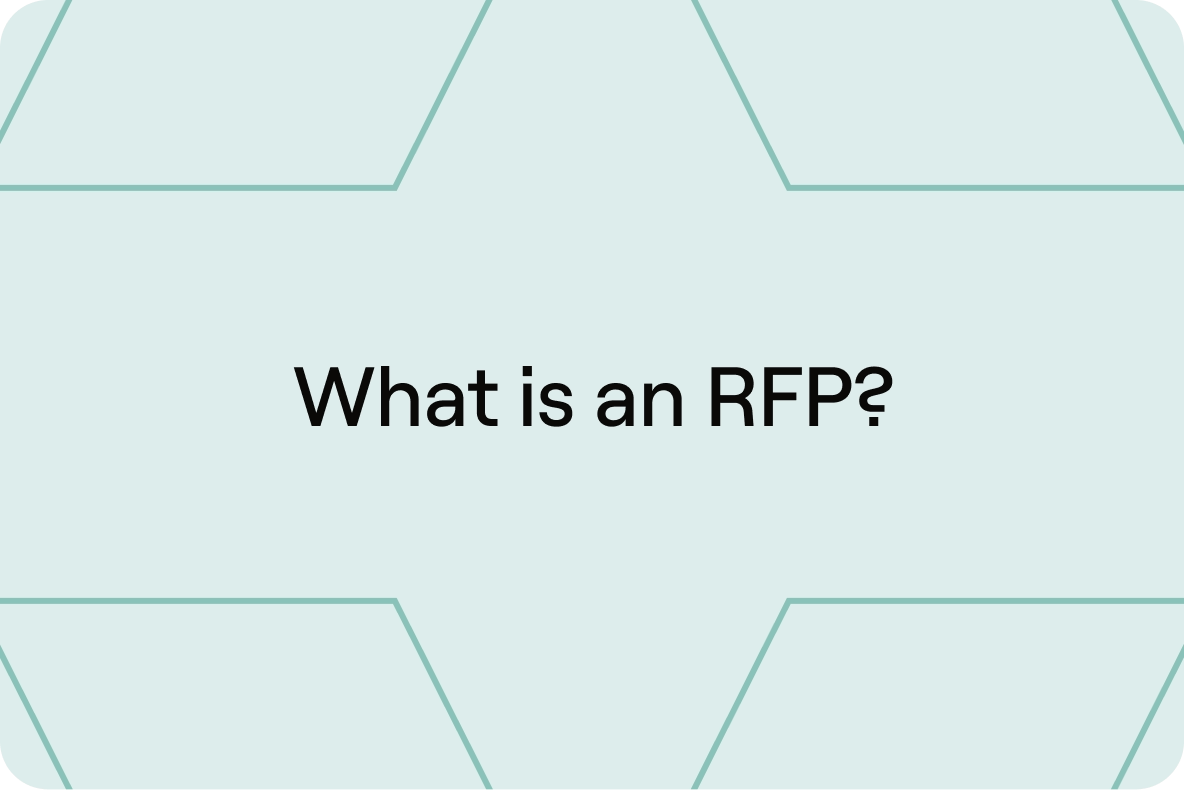The email lands at 4:45 PM on a Friday: "RFP for Enterprise Data Platform".
For revenue leaders, that subject line triggers a familiar conflict. An RFP (Request for Proposal) means a serious buyer with budget authority. It also means mobilizing the team to race to complete 80 pages of technical responses before the next quarterly planning session.
Here's the strategic trap: Most teams treat RFPs as compliance exercises. They assign junior staff to copy-paste from old proposals, then wonder why their win rate hovers at 43%. The real issue isn't workload. It's misunderstanding what an RFP actually signals, and how buyers use it to separate serious vendors from time-wasters.
This guide defines what is RFP, explains why sophisticated buyers issue them for six-figure purchases, breaks down each phase of the process, and shows you how to respond strategically instead of frantically.
Definition: What is an RFP?
RFP stands for Request for Proposal. It's a formal business document that organizations issue to invite qualified vendors to submit detailed, customized proposals for a specific project, product, or service.
The RFP definition hinges on one word: Proposal. The buyer isn't asking for a price quote (that's an RFQ) or general capabilities (that's an RFI). They want you to propose a tailored solution, including implementation methodology, timeline, and cost justification—that solves their specific problem.
What makes an RFP "formal"? Three characteristics:
- Structured questionnaire format: All vendors answer identical questions, making comparison rigorous.
- Weighted evaluation criteria: Buyers score responses numerically (e.g., Technical Approach = 40%, Cost = 30%, Experience = 30%).
- Standardized submission requirements: Specific formatting, page limits, and deadlines ensure fairness.
The request for proposal meaning creates a two-way value exchange. Buyers get comparable proposals they can defend to procurement committees. Vendors get clear requirements that eliminate guesswork about what the buyer actually needs.
Example: A SaaS company evaluating CRM systems issues an RFP with 150 questions covering API integrations, data migration methodology, and compliance certifications. This differs from scheduling three vendor demos and "going with your gut."
Why organizations use RFPs
Organizations issue RFPs to de-risk complex purchases where price is only one factor among many. The RFP purpose is simple: create transparency, force internal alignment, and drive competitive leverage.
RFPs make sense for non-commodity purchases, typically contracts exceeding $100K, where implementation risk, vendor expertise, and long-term partnership quality matter as much as unit cost.
Strategic benefits of the RFP process
1. Ensures fair competition and transparency
Asking all vendors identical questions and evaluating them against the same weighted criteria levels the playing field. For government agencies and public companies, this documented evaluation protects against bias claims and creates an audit trail for stakeholder scrutiny.
2. Forces internal alignment
Drafting an RFP requires the buying organization to define scope, budget, success metrics, and evaluation weightings before engaging vendors. This consensus prevents the classic enterprise problem: Sales loves Vendor A, IT demands Vendor B, and Procurement selects Vendor C based on price alone.
3. Mitigates risk through vendor vetting
Detailed questions about security certifications (SOC 2, ISO 27001), implementation methodology, customer references, and SLA commitments allow buyers to stress-test vendor capabilities on paper before signing a contract. You're not just buying software; you're buying a multi-year partnership.
4. Uncovers creative solutions
Because the RFP asks for a proposal, smart vendors don't just answer questions—they reframe the problem. When Realm evaluated customer support platforms last year, one vendor's proposal identified a workflow bottleneck we hadn't mentioned in the RFP. That insight moved them from third place to finalist.
The honest drawbacks of RFPs
The RFP benefits come with real costs:
- Time-intensive for both sides: Buyers spend 2-4 weeks drafting the RFP. Vendors invest 100-300 hours responding. For complex enterprise software deals, the full cycle stretches 60-90 days.
- Favors compliance over innovation: Poorly written RFPs become checkbox exercises. Vendors win by confirming they meet requirements, not by proposing better approaches. The format rewards thoroughness, which sometimes correlates poorly with product quality.
- Advantages incumbents: Vendors who already understand the buyer's internal systems, politics, and unstated needs hold a structural advantage. If you're responding to an RFP where the buyer already has a preferred vendor, you're likely there to satisfy a "three-bid" procurement policy.
- Locks buyers into initial problem framing: Once issued, RFPs are hard to modify without restarting the process. If the buyer misdiagnoses their problem in the RFP, all proposals will solve the wrong thing.
When RFPs make sense:
- Complex, customized solutions (not commodity purchases like office supplies)
- High-dollar contracts (typically $100K+)
- Multi-stakeholder decisions requiring documented consensus
- Projects with significant implementation or integration risk
When to skip the RFP:
- Commodity purchases with standardized specifications
- Time-sensitive decisions (RFPs add 2-3 months to procurement cycles)
- Small contracts where vendor selection criteria are simple and obvious
RFP vs. RFI vs. RFQ

The RFP abbreviation falls under the umbrella term RFx (Request for X), which includes RFI and RFQ. Think of RFI, RFP, and RFQ as sequential stages in the buyer's journey: Discovery, Solution Design, and Transaction. Many buyers issue an RFI to build a shortlist of 5-7 vendors, then send the RFP only to that qualified group. After selecting a winner, they issue an RFQ for final pricing and contract terms. However, many organizations skip the RFI and go straight to RFP if they already know the vendor landscape. Understanding these differences determines how you allocate response resources.
RFI (Request for Information)
- Purpose: Market research and vendor discovery.
- Buyer's question: "What solutions exist in this space, and who are the credible players?"
- Buying intent: Low. The organization is exploring, not committed to purchasing.
- Your response strategy: Minimal resource investment. Provide high-level capabilities and thought leadership to qualify for the next stage. Don't send your VP of Sales Engineering to answer an RFI.
- Example: A company considering AI-powered sales tools might issue an RFI asking vendors to describe their technology approach, typical use cases, and customer profiles. No pricing, no detailed integration plans.
RFP (Request for Proposal)
- Purpose: Solicit detailed, customized solutions for clearly defined business needs.
- Buyer's question: "We know what problem we need to solve. Show us your best approach, prove your expertise, and justify your cost."
- Buying intent: High. Budget is allocated, stakeholders are aligned, and a decision timeline exists.
- Your response strategy: Maximum resource investment. Customize every answer, demonstrate deep understanding of their industry, and differentiate your methodology.
- Example: The same company issues an RFP detailing their current sales workflow, CRM integration requirements, data security policies, and success metrics. They ask for implementation timelines, pricing tiers, and customer references from similar deployments.
RFQ (Request for Quotation)
- Purpose: Obtain pricing and terms for a well-defined product or service.
- Buyer's question: "We've decided what to buy. Who can deliver it fastest at the best price?"
- Buying intent: Very high. The solution is selected; this is about negotiating terms.
- Your response strategy: Low resource investment. Focus on accuracy and speed. The time for selling value is over; this is a transactional procurement step.
- Example: After selecting Realm as their RFP automation platform, a buyer issues an RFQ requesting pricing for 50 user licenses, implementation services, and annual support. Specifications are locked.
For a deeper strategic breakdown, read our full guide: RFI vs. RFP vs. RFQ: What's the difference?
The RFP process

The RFP process typically spans 30-90 days across five phases: Preparation, Distribution, Vendor Response, Evaluation, and Negotiation. Each phase has distinct activities and timelines. Here's the breakdown.
1. Preparation (Buyer's work)
The buyer defines project scope, budget, technical requirements, and success criteria. They identify the evaluation team, assign scoring weightings to each criterion, and draft the RFP document itself, often 30-100 pages covering company background, technical specifications, submission requirements, and evaluation methodology.
Timeline: 2-4 weeks
Common mistakes: Vague success criteria ("improve efficiency" without quantifying efficiency), unrealistic timelines, or copy-pasting sections from unrelated RFPs.
2. Distribution and Q&A
The RFP is issued to a shortlist of qualified vendors (typically 3-7). Buyers sometis host a bidder conference, a meeting where all vendors can ask clarifying questions. Vendors submit written questions by a deadline, and the buyer issues formal addenda (amendments) to ensure all parties receive identical information. This protects fairness.
Timeline: 1-2 weeks
Strategic note: Smart vendors use the Q&A period to surface unstated needs or challenge assumptions in the RFP. Questions like "Have you considered X approach?" can reshape how the buyer evaluates proposals.
3. Vendor response (Seller's work)
Vendors mobilize cross-functional teams to draft detailed responses. For complex enterprise software RFPs, responses often exceed 200 pages and include written answers, technical architecture diagrams, implementation plans, and pricing tables.
Timeline: 2-6 weeks (deadline set by buyer)
The bottleneck: RFPs for enterprise software typically contain 500+ questions. Even experienced teams spend 100-300 hours per response. During Q4, revenue teams often juggle 8-12 active RFPs simultaneously—which is why many organizations now treat RFP response as a process problem requiring automation, not just more headcount.
4. Evaluation and shortlisting
The buyer's evaluation team scores each proposal against predetermined, weighted criteria. Common categories include Technical Approach (40%), Cost (30%), Vendor Experience (20%), and Implementation Plan (10%). After scoring, buyers shortlist 2-3 finalists and request presentations, product demos, or proof-of-concept trials. They conduct reference checks and security due diligence.
Timeline: 2-4 weeks
Behind the scenes: Most RFP evaluation teams use a scoring matrix. Each evaluator rates each section independently, then the team meets to compare scores and resolve discrepancies. Vendors with inconsistent or incomplete answers get penalized heavily because evaluators must assign a score even if the vendor didn't fully address the question.
5. Negotiation and award
Buyers often request a Best and Final Offer (BAFO) from finalists, a final round of pricing negotiation. Legal teams negotiate contract terms (MSA, SLAs, indemnification clauses), and the buyer selects the final vendor. Public sector buyers typically issue a formal award announcement; private companies often just send a contract.
Timeline: 2-4 weeks
Why deals stall here: Even after "winning," negotiations over security requirements, data ownership, or liability caps can add 30-60 days. Vendors who proactively address these in their RFP response accelerate the close.
Real-world RFP examples
The best RFPs share one trait: they help vendors understand not just what you need, but why you need it. Context separates a strategic RFP from a procurement checklist. Here are three technology RFPs that demonstrate key effectiveness principles.
Case Management Software RFP
This government RFP for legal case management software succeeds because it's specific to legal workflows, not generic software requirements.
What makes it effective:
Instead of vague language like "the system must have reporting capabilities," the RFP describes specific legal workflows: court filing integrations, statute-of-limitations tracking, attorney time-billing, and multi-jurisdictional case linking. Vendors immediately understand the buyer's operational reality.
Key takeaway:
For industry-specific software, include workflow descriptions or process diagrams. Demonstrate you understand your domain's unique needs, and you'll receive proposals that directly address those needs instead of generic feature checklists.
Mobile App Development RFP
This RFP for an augmented reality mobile app for a memorial park is unusual—which forces the buyer to provide exceptional context.
What makes it effective:
The RFP blends a creative brief (the vision for the AR experience) with detailed technical specifications (GPS integration requirements, AR framework preferences, CMS backend needs). It includes site maps and visual mockups to help developers understand the physical space and user journey. Vendors can visualize the end product before proposing.
Key takeaway:
For innovative or uncommon projects, don't assume vendors understand your vision. Provide visuals, user stories, and detailed functionality descriptions. The more unusual the project, the more context you must supply. Ambiguity kills creativity.
Information Systems Risk Assessment RFP
This RFP for a security assessment succeeds because it demonstrates the buyer is a sophisticated consumer of security services.
What makes it effective:
The RFP clearly defines scope (assess current security posture, identify vulnerabilities, evaluate controls against NIST framework) and lists explicit deliverables (risk assessment report with severity ratings, remediation roadmap with prioritized recommendations). It specifies required vendor qualifications: certifications (CISSP, CISM), experience with FISMA compliance, and methodology for testing without disrupting operations.
Key takeaway:
For high-stakes services like security assessments or compliance audits, demonstrate you understand the risks and what thorough evaluation entails. This attracts high-caliber vendors who know their methodology will be rigorously evaluated, and repels vendors hoping to win on price alone.
For 30+ annotated examples across software, consulting, construction, marketing, and education, see our full guide: RFP Examples: 30 Real Requests for Proposal from 5 Industries
Automate RFP responses with Realm

Realm is designed to streamline your entire response process, including RFPs, RFIs, RFQs, and security questionnaires such as VSQs, CAIQs, SIGs, DDQs. By connecting directly to your company's existing knowledge base, Realm's AI agents can automate up to 80% of your response drafting, allowing your team to focus on review and strategic customization.
7 steps to automate RFP responses
Realm provides a centralized platform for managing the entire bidding process, from initial upload to final submission.
1. Upload the questionnaire
Start by uploading the unfilled RFP file directly to the Realm platform. Realm supports diverse file formats, including Excel, PDF, and Word.
2. Analysis and parsing
Realm automatically analyzes the document, recognizing which questions, columns, or tables require a response. The system breaks the RFP down into manageable sections for processing.
3. Choose your AI Agent
You can set up specialized AI Agents for different question types, product verticals, or customer segments. Each Agent can be grounded in a specific subset of your knowledge base to ensure the most relevant information is used.
4. Automate drafting
Realm drafts comprehensive, accurate, and compelling responses in your company’s language and tone of voice. Every answer is grounded in your company’s verified knowledge base, including past winning proposals. To ensure accuracy and easy verification, Realm cites the sources it references for every generated answer. This process prevents AI "hallucinations" by only using your approved, factual content.
5. Review and collaborate
AI drafts are complete in minutes, you can seamlessly review and finalize the responses with your team. You can manually edit the answer, approve it if it's final, or write a follow-up prompt asking the AI for edits or additions. You can also sssign specific questions or sections to subject-matter experts (SMEs) for finalization.
6. Export and submit
Once all answers have been reviewed and approved, you can export the finalized document. The exported file will maintain the exact structure and formatting of the original RFP spreadsheet or document.
7. Repurpose winning responses
After the RFP is completed and approved, the finalized responses are automatically added back into your knowledge base. This ensures that future AI Agents will automatically draw on your latest winning answers, continually improving response quality and consistency.
Final thoughts on RFPs: From compliance to competitive advantage
The request for proposal meaning has shifted. What began as a procurement compliance document for government contracts has evolved into a strategic inflection point in complex B2B sales cycles.
For revenue leaders, the challenge isn't avoiding RFPs. It's mastering the economics of response. If you can respond to more opportunities, faster, and with higher quality, you fundamentally change your win rate and pipeline velocity.
The vendors who win consistently today combine efficiency with strategic customization. They automate the repetitive work (boilerplate company background, standard security questionnaires, compliance certifications) to free their senior talent for high-leverage activities: tailoring the solution narrative, demonstrating differentiated value, and building relationships through personalized communication.


